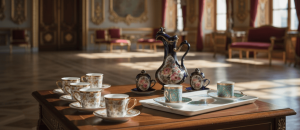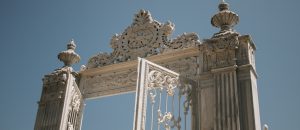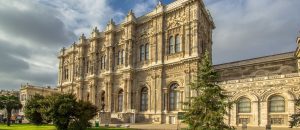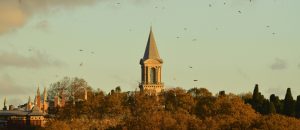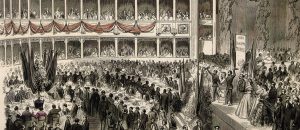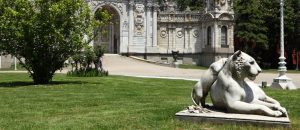When visiting Dolmabahçe Palace, you actually discover two interwoven, different worlds: the Selamlık and the Harem. These two sections are not merely an architectural separation; they are also two distinct stages where the 19th-century Ottoman Sultan’s public and private identities—namely, his roles as statesman and family patriarch—were enacted. While the Selamlık is the face of the empire exhibited to the world, the center of power and protocol; the Harem is the private and intimate space where the Sultan lived with his family, isolated from the outside world. Understanding the fundamental differences between them as you tour these two sections will help you grasp how sharply the boundaries between state administration and private life were drawn in a modernizing empire.
Selamlık: The State’s Showcase and Stage of Power
The Selamlık section, where you begin your visit, is, as its name suggests (“the place of greeting”), the public area where state affairs were conducted and local and foreign guests were hosted. This is the empire’s showcase.
Who is it for?: Grand Viziers, nazırs (ministers), pashas, bureaucrats, foreign ambassadors, and heads of state. Entry into this section is forbidden to women (except for dynasty members) and anyone without the Sultan’s permission.
The Language of Architecture: It is designed to be as magnificent, monumental, and formal as possible. High ceilings, colossal columns, large ceremonial staircases (the Crystal Staircase), and perfect symmetry prevail. The goal is to make the visitor feel the overwhelming power and order of the state.
** The Message of Decoration:** Every object used in the decoration is a symbol of power. [Link: Queen Victoria’s massive chandelier -> /diplomasinin-kristalleri-dolmahcenin-avize-ve-samdan-koleksiyonunun-dunyaya-gonderdigi-isiltili-mesajlar], the Russian Tsar’s malachite vases, valuable Hereke carpets…. All are there to showcase the wealth and international relations of the empire. Colors are generally more serious and formal (red, gold leaf, dark wood tones).
Key Locations:
Medhal Hall: The impressive reception hall where the initial entrance to the palace was made.
Crystal Staircase: A path of prestige that takes the visitor upstairs to more important locations.
Süfera Hall (Ambassadors’ Hall): The center of diplomacy where foreign ambassadors were hosted.
Muayede Hall (Ceremonial Hall): The stage of power where the empire’s grandest ceremonies (such as holiday greetings, etc.) took place.
What Should You Look for When Touring the Selamlık?: You should look for power, order, symmetry, grandeur, and international diplomacy. This is “the theater of the state“.
Harem: The Family’s Fortress and Private Living Area
When you move from the formality of the Selamlık to the Harem section, you witness how the architecture and atmosphere soften. Harem means “forbidden/intimate,” and it is the private area where the Sultan, his mother the Valide Sultan, his consorts (kadınefendiler), his children (şehzadeler and sultans), and the servants (cariyeler) lived.
Who Does It Belong To?: Only the Sultan and his family. No foreign male can enter this section without the Sultan’s permission.
The Language of Architecture: It is designed on a more human scale than the Selamlık, less monumental, and meant to feel more like a “home“. Corridors are narrower, rooms are smaller, and ceilings are lower. Functionality and comfort take precedence over concerns of symmetry.
The Spirit of Decoration: The decoration reflects the family’s taste and comfort rather than displaying power. More elegant and less ostentatious furniture, lighter and pastel colors (pink, blue, green), floral patterned wallpapers, and curtains prevail. The objects here are personal belongings of family members rather than [Link: diplomatic gifts -> /hediyelerle-yazilan-tarih-dolmahcenin-yabanci-liderlerden-gelen-diplomatik-hazineleri].
Key Locations
Valide Sultan Apartment: The largest and richest apartment, where the most respected person of the Harem lived.
The Sultan’s Private Apartment and Bath (Hamam): The most private locations where the Sultan rested, worked, and purified himself.
Kadınefendiler and Şehzadeler Apartments: The private living quarters of the dynasty members.
Blue Hall / Zülvecheyn Hall: Common halls where the Harem populace held their own internal ceremonies, such as holiday greetings.
What Should You Look for When Touring the Harem?: You should look for family life, privacy, comfort, and [Link: changing roles of women and children -> /kafes-arkasindan-bogaz-manzarasina-dolmahce-hareminin-kadinlari-nasil-degisti]. This is “the fortress of the family“.
Two Worlds, One Sultan
Touring Dolmabahçe Palace in its two sections, Selamlık and Harem, is a unique opportunity to understand the divided identity of a modernizing Ottoman Sultan. In the Selamlık, he is an emperor wearing his frock coat, speaking French with foreign ambassadors, and administering the state. When he moves to the Harem, however, he is a family man, wearing his kaftan, being with his family, and continuing his traditional life. The architectural and atmospheric difference between these two sections is the story of a ruler and an empire living between East and West, between tradition and modernity, and between public identity and private identity.








